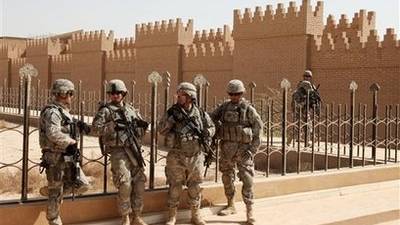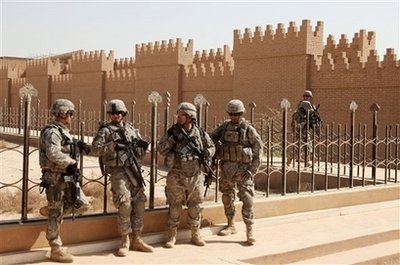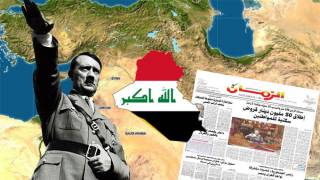UNESCO Report on Babylon: US occupation caused “major damage” to historic site in Iraq
Source: unobserver.com
UNESCO, the United Nations cultural organization, has issued a report outlining the extensive damage caused by US occupation forces in Iraq to the archeological site of ancient Babylon, about 100 Km (60 miles) south of Baghdad.The report was based on examinations of the site by prominent specialists, including John Curtis, John Russell and Elizabeth Stone.
It charges American and Polish forces with carrying out “a grave encroachment on this internationally known archaeological site.”
The report continues, “During their presence in Babylon, the MNF-I [Multi-National Forces] and contractors employed by them, mainly KBR, directly caused major damage to the city by digging, cutting, scraping, and leveling. Key structures that were damaged include the Ishtar Gate and the Processional Way.”
The site of Babylon is of major historical and scientific importance. Babylon was a leading city of ancient Mesopotamia in what is now modern Iraq. It is one of the oldest centers of civilization in the world, and the origin of many social and technological discoveries that form the basis of modern culture. Babylon is first mentioned in baked clay tablets from the area over 4,000 years ago.
The city is best known for two of its rulers: Hammurabi (1792-1750 BC), who enacted one of the world’s first codes of law; and Nebuchadnezzar (604-562 BC), who built the Hanging Gardens of Babylon, one of the Seven Wonders of the ancient world. Babylon was conquered by Alexander the Great, who died there in 323 BC. The city figures prominently in the Old Testament. After the Islamic period, the location of the city was forgotten.
Babylon was first scientifically excavated by the German archaeologist Robert Koldewey in 1899, and many important finds were made in the subsequent colonial period, including that of the splendid Ishtar Gate. A reconstruction of the gate, with materials supplied by Koldewey, now stands in Berlin’s Pergamon Museum.
Archaeologists from the German Archaeological Institute made significant finds between 1962 and 1973. Excavations have been conducted since 1977 under the auspices of the Iraqi State Board of Antiquities and Heritage (SBAH).
The Baathist regime of Saddam Hussein initiated the Babylon Archaeological Restoration Project. The aim of the regime was to reinforce nationalist sentiment, and, alongside serious study of the site, there was the irresponsible addition of new structures. A palace for Hussein was built there, in addition to parking lots, a restaurant, artificial mounds and canals. In addition, according to the UNESCO report, faulty restorations of ancient buildings were made.
Shortly after the American invasion, the Nebuchadnezzar and Hammurabi museums on the site were looted. Only plaster replicas of ancient objects were stolen. Much more serious was the burning of the Babylon Library and Archive, which contained valuable archaeological records.
In April 2003, the United Sates military, and eventually Polish troops, occupied the site and later made a permanent installation called Camp Alpha that remained there until December 2004, when the site was handed back to SBAH.
The US military cordoned off the area with barriers and barbed wire and contracted the notorious subsidiary of Halliburton, KBR, to do much of its construction work.
Coalition forces or KBR dug eight trenches—including one over 160 meters long—all over the site of the ancient city. The soil that was removed was either piled up on the sides of the trenches or put into barricade-like HESCO containers. UNESCO reports that in case after case, the soil removed contained “fragments of ancient baked brick and pottery.”
Even small ceramic fragments have scientific importance since they can help archeologists date the layers or reconstruct the layout of the city. When they are moved from their context, this becomes nearly impossible. In some cases, the trenches themselves cut into ancient surfaces.
In order to build roads or erect earthen barriers, the military occupation forces dug pits on the ancient site and cut into mounds or tells, which have been formed by thousands of years of accumulation of human debris. One description in the report reads, “A section through the cut shows a deposit with various archaeological fragments.” Some cuts removed entire sides of mounds or extended into ancient walls of baked brick.
Occupation forces scraped and leveled a number of archaeological areas and tells. Some were subsequently covered with sand and gravel to make parking lots for military equipment.
The report notes, “This operation covered broad areas of Babylon and entailed the use of heavy equipment to compact the soil, which may have destroyed any antiquities beneath the surface. The effects of chemical treatment on the archaeological sub-surface layers are not yet known.”
Banks of earth were constructed with debris from the trenches, which, according to the UNESCO report, contained bricks with inscriptions from the Nebuchadnezzar period.
The occupation forces also drove steel stakes into ancient walls, which also included fragments with inscriptions from the time of Nebuchadnezzar.
The report outlines the direct damage inflicted by occupation forces on ancient monuments that constitute some of the most important artistic accomplishments of ancient Mesopotamian cultures, such as the remnants of the Ishtar Gate.
“The damage to the gate includes smashed bricks on nine of the bodies of animals adorning the gate. These animals depict the legendary dragon-snake, the symbol of Marduk, the god of the city of Babylon.”
There was also egregious damage to the Processional Way of the city. The report notes the marks of heavy vehicles that broke the ancient paving of the street. In addition, “Three rows of 2-ton blocks were placed in the middle of the Processional Way on top of the paving,” which were removed by helicopter in 2004.
The vibrations of heavy equipment in the area damaged other archaeological structures. The roof of the Ninmakh Temple, which had a busy helicopter pad constructed next to it, collapsed.
To compound the damage, the occupation forces refused to allow SBAH personnel onto the site to conduct maintenance and restoration of the ancient buildings.
Occupation forces also damaged the modern buildings of the site, including the offices the Museums and the Study Center, “rendering them shells devoid of doors, windows, and electrical fixtures,” according to the report.
Since the withdrawal of foreign military forces from the area, the site has continued to be disrupted by the infighting within the US-installed Iraqi government. The local governor of the province is currently building a large garden on the site and has flattened an area of the site with a bulldozer. He and SBAH have disputed the rights to access the area.
The UNESCO report makes a number of recommendations, including an investigation of the long-term implications of the damage to the site. It also calls for making the archaeological area of Babylon a World Heritage Site, the most prestigious and best-funded status that the organization can grant to a historic site.
While necessary, these suggestions take no account of the criminal nature of the destruction of the site that took place under the auspices of the American occupation.
In spite of repeated warnings by archaeologists before and during the war, the American-led occupation forces acted with deliberate disregard for the cultural heritage not only of the Iraq people, but indeed, of the entire planet.
The Bush administration and the American political establishment, including the Democratic Party, which facilitated the invasion of Iraq, are responsible for the lootings and burnings of libraries, archives and museums all over Iraq after April 2003—and the continued looting of archaeological sites to feed the illegal market in antiquities.
The UNESCO report, by the very nature of the organization issuing it, cannot draw the logical conclusion that flows from its findings: that the damage to Babylon is part of a larger war crime, for which those responsible should be criminally investigated and tried.
But the details of the report speak for themselves: the American presence led to the vandalism of one of the oldest cities in the world.
That this crime is largely overlooked is only because it pales in comparison to the deaths of over a million Iraqis and the continued displacement and poverty of millions more since the 2003 American invasion.
The damage to Iraq’s archaeological sites, libraries, and museums and to the educational system remains, however, a crucial part of the sociocide—the destruction of a whole society—carried out in Washington’s attempt to seize control of its natural resources and strategic location.
Article from: UNObserver.com
Babylon's history swept away in US army sandbags
Hugh Montgomery - The God-Kings: Babylon, Ulvungar & Oden
Jim Marrs - The Terror Conspiracy
Jim Marrs - The Secret Society Agenda, Alien or Human?
William Henry - Stargates & Starwalkers
Peter Levenda - Sinister Forces























